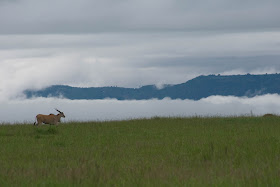I have now been
in the Mara for almost 2 months! Where did the time go, you ask? I am asking
myself that same question. I woke up and all of a sudden, it was the end of
April. Do you ever wake up and feel like your whole life has gone by?
No, actually, I
am happy to say that I have started my field project; the very thing I came
here to do! And boy, has it been an adventure! Who knew so many problems would
arise, ha! For my field project, I am conducting scent-discrimination trials
where I basically present hyenas with the scent gland secretions (paste) of 2
other hyenas they have never met. I smear the paste on the tops of two, thick
wooden sticks, hammer them into the ground, and then videotape the
interactions. We think that these scent gland secretions, which are most likely
synthesized with the help of bacteria, encode information about the hyena; such
as their sex, age, and social group. Back at camp, I review the videos and
record the amounts of time hyenas spend sniffing each of the sticks. If at the
end, hyenas smell one of the sticks (paste) more, then that would suggest that
the sticks are not the same and are indeed encoding different information.
It has been
extremely fun to conduct these trials! The cubs are highly entertaining! They
get really interactive with the sticks; not only do they sniff them, but they
also bite them, and rub against them. On one occasion, they completely removed the
sticks from the ground and ran off with them (bye, bye, stick!). That stick
became their new favorite toy (Awww!). I thought, hmm, maybe the sticks are too
thin, so I bought thicker sticks that I have been really hammering into the
ground. This has worked; the cubs have not been able to take them, except now,
the subadults are taking them 🙃 🙃
🙃. Bless their hearts. Can’t blame them;
they are curious about the actual stick and the scents of these 2 hyenas they
have never met before! Addressing this issue is currently one of the things I
am working on. Another issue I need to work on is getting more adult
participation. They usually come late into the evening, but so far, rain has
forced us to terminate the trials early. I hope that once these rains leave, I can
conduct my trials more frequently and stay out longer; increasing my chances of
encountering adults. I’ll have to get creative about where I position the
sticks as well 🤔 🤔 🤔.
Here is a hyena cub sniffing my sticks:
Overall, the
field work has been fun! What else has been fun? Seeing all of the animals,
getting to know the staff, RAs and grad students here, watching 30 Rock,
stuffing my face with French toast (my favorite), sleeping in, getting fancy
juices at the lodge, and sharing my experience with my family via the pictures
I take 😊 😊 😊.
Well, that’s it
for today!








